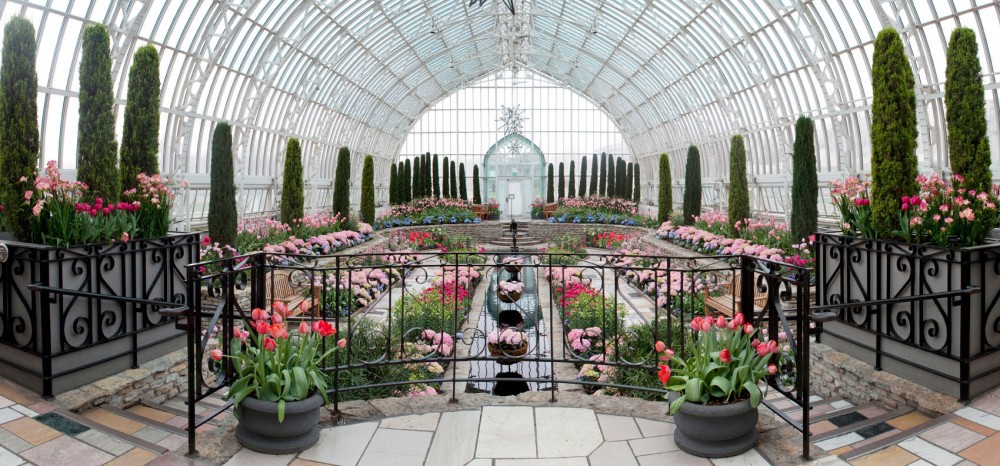What: Spring Flower Shows
Where: Macy’s, 700 Nicollet Mall, Minneapolis
Como Park Zoo and Conservatory, 1225 Estabrook Drive, Saint Paul
When: Macy’s: 10 a.m.-8 p.m., Monday through Saturday, 12 p.m.-6 p.m., Sunday
Como Conservatory: 10 a.m.-6 p.m. everyday
Price: Free
As sinuses everywhere inform their owners that spring has leapt in a little early this year, Macy’s and the Como Park Conservatory prepare to share the wealth of Minnesota’s most elusive season. This year, with trees and temperatures already providing their own release from parka-trussed bondage, the flower shows must serve a new purpose. Being warm and vibrant is no longer enough — this year, they need to be art.
Artistry was certainly evident at both shows when A&E visited for previews. However, the artistic approach taken by the two organizations was diametrically opposed. Here’s the rundown of how these polar counterparts approached the world of grand floral design.
Macy’s Flower Show
700 Nicollet Mall, Minneapolis
The eighth floor of Macy’s begins at a long corridor filled with Brazilian cafe music, an aural purveyor of this year’s Flower Show theme — Brasil.
“We were so lucky to work with the Brasil theme this year,” said Bachman’s Flowers CEO Dale Bachman, whose company takes care of gardening for the show. “The country is so diverse that we had a lot of directions to explore.”
Velvet ropes lead into a massive auditorium, filled front and center with a 12-foot tall flower petal toucan. The colors are so intense that it is hard to breathe sometimes — great sweeping showers of red and gold and white that fill every inch of the room.
The set was designed by Jack Barkla, who has crafted scenes for theater and opera companies across the Twin Cities.
The scenery is intense, certainly, and varied. Though this occasionally distracts from the arrangement of the flowers themselves, it adds an air of travel and adventure to the show. You feel like you’re making your way through the jungle into the streets of Rio, and they even hid a few plastic critters in the flowers to heighten the sensation.
Various parts of the set at once resemble the rainforest, colonial settlements and the barrios of modern Brazilian cities. Look closely at parts of the sidewalk and you can see mosaics in the style of the late Roberto Burle Marx, Brazil’s foremost landscape architect. Even the swatches of color at the edges of the exhibit were designed to draw your eyes along the aisles, placed with a distinct purpose.
What of the flowers, then?
A large portion of the vegetation at the show is native to Brazil — mahogany, cocoa, banana and pineapple filled the rainforest section, while orchids and bromeliads crept along the ground throughout. A few others might grow in Brazilian gardens but certainly had no roots in the country, such as the coffee trees and daffodils.
Many of these plants were imported just for the show, cultivated in greenhouses and forced to bloom in time for the exhibit’s opening. The blocks of color they formed were bright and beautiful, and the texture inherent in diverse flower shapes lent an M.C. Escher-esque feel to some displays.
The cost of this beauty is high, however.
“It’s difficult for the plants to live in this environment for two weeks,” Bachman said. “In the end, most plants give their lives for the show.”
Brasil was a high-concept, high-octane show bound by a grand notion. The journey down Como to the Conservatory yielded a different kind of spring vision, however.
Como Park Zoo and Conservatory Spring Flower Show
1225 Estabrook Drive, St. Paul
The sunken garden at Como Conservatory appears small after the elephantine floorplan in Macy’s, but glass ceilings give the light within a natural and calming slant.
The room is done in the formal European style, featuring long straight lines and exacting symmetry, Como’s head gardener Paul Knuth told A&E during a visit.
The theme at Como this year is baby pink and baby blue. Swatches of both colors blended subtly into one another through purple intermediaries, and the smooth transitions almost begged to be followed at an amble.
“The conservatory is a wonderful place to come study, with the quiet and natural light,” Knuth added. “As the weeks go on, the show will transition from primarily pink to primarily blue, and every day it will grow a little more in one direction.”
The artistry here lies in the intricacies of flower choice and design rather than grand-scale production. Flowers were picked to complement the height, shape and color of their neighbors perfectly, creating an uninterrupted flow of slightly shifting lines. Every flower was placed carefully to maximize effect.
“The tall lilies in the outside rows were pointed slightly in, while the low rows in the middle are arched. The final effect is very pleasing to the eye from a distance and up close,” Knuth said.
Como cultivated its blooms in a greenhouse as well, but most of the flowers here are regularly grown in Minnesota. At the same time, Como has the facilities to upkeep or shift their flower stock to different places and will even take some of the plants from Macy’s that would otherwise die after their show.
Como’s Spring Flower Show was a spectacle of subtlety, proving that attention to detail can provide as much room for thought as lofty conceptual work. In that way, it could not differ more from the Macy’s Carnival atmosphere.
Despite these differences, though, there was one thing that both organizations could agree on.
In the words of Dale Bachman, “It’s a great place to go on a date!”








